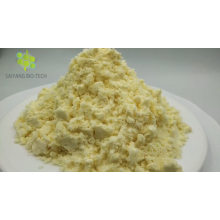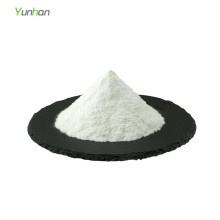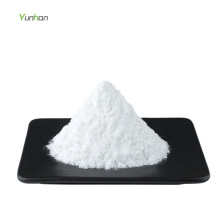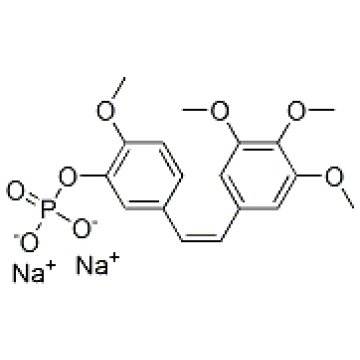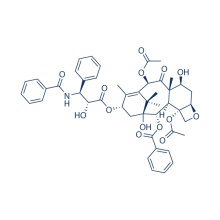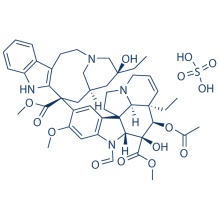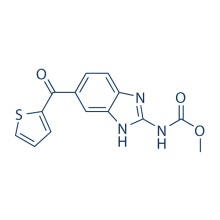Fosbretabulin (Combretastatin A4 Phosphate (CA4P)) Disodium 168555-66-6
Product Description
Molecular Weight: 440.29 Fosbretabulin (Combretastatin A4 Phosphate (CA4P)) Disodium is the water-soluble prodrug of Combretastatin A4 (CA4), which is a microtubule-targeting agent that binds β-tubulin with Kd of 0.4 μM. Fosbretabulin Disodium inhibits the polymerization of tubulin with IC50 of 2.4 μM, and also disrupts tumor vasculature. Phase 3.
Biological Activity
Fosbretabulin disodium (Combretastatin A-4 phosphate disodium, CA4P
disodium) is the water-soluble prodrug of combretastatin A4 (CA4), which
is originally isolated from African tree Combretum caffrum. CA4
is a tubulin-binding agent that binds at or near the colchicine binding
site of β-tubulin (Kd = 0.40 μM), inhibits tubulin assembly with IC50 of
2.4 μM. CA4 is cytotoxic towards proliferating but not quiescent
endothelial cells, has potent and selective toxicity towards tumor
vasculature. CA4P (1 mM, 30 minutes) disrupts the endothelial
microtubule cytoskeleton and mediates changes in endothelial cell
morphology.
CA4P stimulates actin stress fiber formation and membrane
blebbing and increases monolayer permeability via Rho/Rho-kinase. CA4P
increases endothelial cell permeability, while inhibiting endothelial
cell migration and capillary tube formation predominantly through
disruption of VE-cadherin/β-catenin/Akt signaling pathway, thereby
leading to rapid vascular collapse and tumor necrosis.
CA4P causes rapid, extensive and irreversible vascular shutdown in
experimental tumor models following the administration of a single dose
at 10% of the maximum tolerated dose (MTD). CA4P causes a 93% reduction
in vascular volume 6 h following drug administration. CA4P(100 mg/kg, 6
h following administration) reduces tumor blood by approximately
100-fold, compared with approximately 7-fold in the spleen.
Protocol(Only for Reference)
Kinase Assay:
[1]
| Tubulin assembly-disassembly | The assembly of microtubules from isolated tubulin is carried out spectrophotometrically at 350 nm and utilises the increase in turbidity which is associated with microtubule formation. Assembly is initiated by temperature increase from 10 to 35 °C. The effect of drugs on the increase in light absorption is carried. Drugs are dissolved in DMSO ( |
|---|
Cell Assay:
[4]
| Cell lines | HUVECs |
|---|---|
| Concentrations | ~50 nM |
| Incubation Time | 12-48 h |
| Method | For the proliferation assay, the minimal concentration of FBS (1%) diluted in X-VIVO medium is used to allow sufficient viability of endothelial cells. After detachment, the cells are seeded at a concentration of 2×104 HUVECs in each well of 24-well plates, allowed to adhere overnight, and then incubated with or without cytokines (5 ng/ml FGF-2 or 5 ng/ml VEGF-A). CA4P is added at 0 – 50 nM. After incubation for 12, 24, 36, and 48 hours, cells are detached by trypsin/EDTA and manually counted using trypan blue exclusion. |
Animal Study:
[5]
| Animal Models | BD9 rats implanted with tumor | ||
|---|---|---|---|
| Formulation | 0.9% saline with a few drops of 5% Na2CO3 | ||
| Dosages | 100 mg/kg, 3 ml/kg | ||
| Administration | i.p. | ||
| Solubility | Saline with a few drops of 5% Na2CO3 , 30 mg/mL | ||
| * Please note that Selleck tests the solubility of all compounds in-house, and the actual solubility may differ slightly from published values. This is normal and is due to slight batch-to-batch variations. | |||
Conversion of different model animals based on BSA (Value based on data from FDA Draft Guidelines)
| Species | Baboon | Dog | Monkey | Rabbit | Guinea pig | Rat | Hamster | Mouse |
| Weight (kg) | 12 | 10 | 3 | 1.8 | 0.4 | 0.15 | 0.08 | 0.02 |
| Body Surface Area (m2) | 0.6 | 0.5 | 0.24 | 0.15 | 0.05 | 0.025 | 0.02 | 0.007 |
| Km factor | 20 | 20 | 12 | 12 | 8 | 6 | 5 | 3 |
| Animal A (mg/kg) = Animal B (mg/kg) multiplied by | Animal B Km |
| Animal A Km |
For example, to modify the dose of resveratrol used for a mouse (22.4 mg/kg) to a dose based on the BSA for a rat, multiply 22.4 mg/kg by the Km factor for a mouse and then divide by the Km factor for a rat. This calculation results in a rat equivalent dose for resveratrol of 11.2 mg/kg.
| Rat dose (mg/kg) = mouse dose (22.4 mg/kg) × | mouse Km(3) | = 11.2 mg/kg |
| rat Km(6) |
Chemical Information
| Molecular Weight (MW) | 440.29 |
|---|---|
| Formula | C18H19O8P.2Na |
| CAS No. | 168555-66-6 |
| Storage | 3 years -20℃Powder |
|---|---|
| 6 months-80℃in solvent (DMSO, water, etc.) | |
| Synonyms | |
| Solubility (25°C) * | In vitro | DMSO | <1 mg/mL ( |
|---|---|---|---|
| Water | 28 mg/mL (63.59 mM) | ||
| Ethanol | <1 mg/mL ( | ||
| In vivo | Saline with a few drops of 5% Na2CO3 | 30 mg/mL | |
| * <1 mg/ml means slightly soluble or insoluble. * Please note that Selleck tests the solubility of all compounds in-house, and the actual solubility may differ slightly from published values. This is normal and is due to slight batch-to-batch variations. | |||
| Chemical Name | Phenol, 2-methoxy-5-[(1Z)-2-(3,4,5-trimethoxyphenyl)ethenyl]-, 1-(dihydrogen phosphate), sodium salt (1:2) |
|---|
Molarity Calculator
Dilution Calculator
Molecular Weight Calculator
Contact us if you need more details on 168555-66-6. We are ready to answer your questions on packaging, logistics, certification or any other aspects about Fosbretabulin 168555-66-6、168555-66-6 Fosbretabulin. If these products fail to match your need, please contact us and we would like to provide relevant information.
Product Categories : Cytoskeletal Signaling > Microtubule Associated Inhibitor




